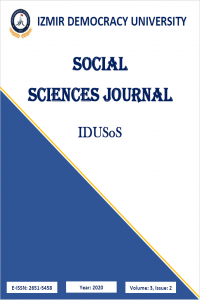TRIALİSM - ÇİFT MONARŞİNİN SİYASİ OLARAK YENİDEN DÜZENLENMESİ KONUSU
Halkların Baharından Sonra 1848/49, ulusun mutlak bir hükümdar figürü aracılığıyla temsil edildiği eski devlet biçimlerinin sona erdiği aşikardır. Zaman Ulus-devletlerin zamanıdır ve artık çok sayıda milletten oluşan eski monarşilerin hayatta kalamayacakları giderek daha da kesinleşmiştir. Eski Habsburg İmparatorluğu, sonunu ilk burjuva devrimlerinde bulan bir dönemin en bariz örneği olmuştur. Değişiklikler kaçınılmazdı, bunlardan ilki, en büyük iki halk monarşisi, Almanlar ve Macarlar arasındaki 1867 Uzlaşması ve ardından ertesi yıl Budapeşte ve Zagreb parlamentoları arasındaki Uzlaşma olmuştur. Yazar, takip eden olaylara ve 1918'de Tuna Monarşisinin nihai çöküşünü engellemeye çalışan olası çözümleri değerlendirecektir.
Anahtar Kelimeler:
Deneme, Avusturya-Macaristan, Yerleşim, Triune Krallığı, Yeniden Yapılanma.
TRIALISM – THE ISSUE OF POLITICAL REORGANIZATION OF THE DUAL MONARCHY
After the Spring of the Peoples 1848/49 it became obvious that the old state forms came to an end where the nation was represented through the figure of an absolute monarch. The times of nation-states has come and it is increasingly certain the old monarchies, composed of a multitude of nationalities, cannot in the end, as such, survive. The old Habsburg Empire was the most obvious example of a period that found its end in the first bourgeois revolutions. The changes were indispensable, the first of which was the Settlement of 1867 between the two largest people's Monarchies, the Germans and the Hungarians, followed by the Settlement between the parliaments of Budapest and Zagreb the following year. The author will analyze the events that followed, and at the potential solutions that tried to prevent the final collapse of the Danube Monarchy in 1918.
Keywords:
Trialism, Austro-Hungary, Settlement, Triune Kingdom, Reorganization,
___
- Andabak Fernandez, Katarina. (2015). Bahov apsolutizam (note final paper, J. J. Strossmayer University of Osijek).
- Bjelovučić, Nikola Zvonimir. (1911). Trijalizam i hrvatska država. Dubrovnik, Nakladnik N. B.
- Bresić Mikulić, Ante. (2017). Veksiološka analiza i rekonstrukcija trijalističkih prijedloga do 1918. in Obnova, Journal of Culture, Society and Politics, 134-156, 9/2017 .
- Culinovič, Ferdo. (1961). Državnopravna historija jugoslavenskih zemalja Zagreb: Školska knjiga.
- Gross, Mirjana. (1973). Povijest pravaška ideologije. Zagreb: Institut za hrvatsku povijest.
- Hondiu , Frederik Willem and Hondius, Frits Willem. (1968). The Yugoslav Community of Nations . Berlin: De Gruyter Mouton.
- Imamović, Mustafa. (2003). Historija države i prava Bosne i Hercegovine. Sarajevo: Magistrat.
- Imamović, Mustafa. (2006). Osnove upravno-političkog razvitka i državnopravnog položaja Bosne i Hercegovine. Sarajevo: Pravni fakultet Univerziteta u Sarajevu.
- Janković, Dragoslav and Mirković, Mirko. (1997). Državnopravna istorija Jugoslavije. Beograd: Draganić.
- Jellinek, Georg. (1882). Die Lehre von den Staatenverbundungen. Vienna: Alfred Holder, K. Hof- und Universitäts-Buchhändler.
- Jevtić, Dragoš and Popović, Dragoljub. (2003). Narodna pravna istorija. Beograd. Savremena administracija.
- Jovanović, Jovan M. (1929). Stvaranje zajedničke države Srba, Hrvata i Slovenaca, Knjiga druga. Beograd: SKZ.
- Jovanović, Jovan M. (1930). Stvaranje zajedničke države Srba, Hrvata i Slovenaca, Knjiga treća. Beograd: SKZ.
- Kann, Robert A. (1964). The Multinational Empire: Nationalism and National Reform of Habsburg Monarchy 1848/49, Vol. I, Empire and nationalities. New York: Octagon books.
- Matković, Stjepan. (2001). Čista stranka prava: 1895-1903 . Zagreb: Hrvatski institut za povijest.
- Pilar, Ivo. (1918). Južnoslavensko pitanje i Veliki rat. Vienna: UB.
- Pilar, Ivo. (1917). Svjetski rat i Hrvati . Zagreb: KMB.
- Pliverić, Josip. (1885). Die rechtliche Verhältniss Kroatiens zu Ungarn. Agram: Kugli und Deursh.
- Šarkić, Srđan. (1999). Opšta istorija države i prava. Belgrade: Draganić.
- Šišić, Ferdo. (1962). Pregled povijesti hrvatskoga naroda. Zagreb: Matica hrvatska.
- Starčević, (1943). Ante. Izabrana djela, prepared by Blaž Jurišić. Zagreb: HIBZ.
- Başlangıç: 2018
- Yayıncı: İzmir Demokrasi Üniversitesi
